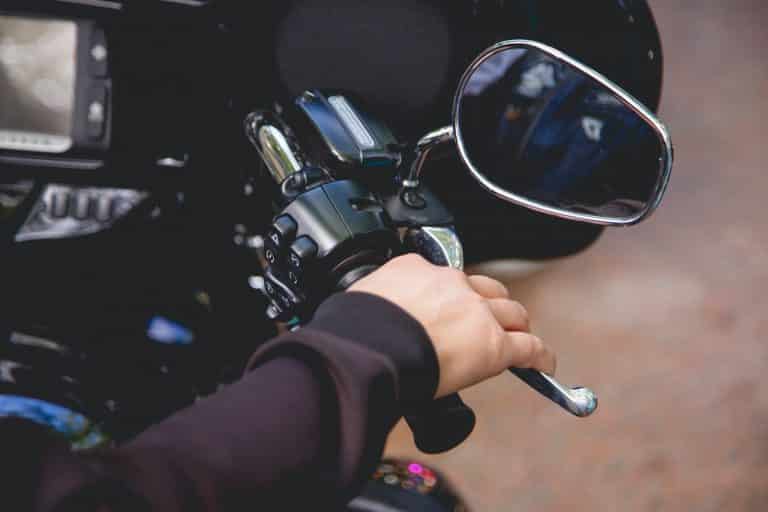There are many ways of stopping a motorcycle. Some people might choose to use the front brake more than the back brake. Others might just slam on the brakes without even thinking about it, and that is dangerous especially if you’re riding in traffic or at high speeds where taking your foot off of the throttle would be enough to cause an accident. When it comes to stopping your motorcycle the smoothest there is only one way that works the best.
Only use your rear brake at the tail end of your stop will give you the smoothest way to stop a motorcycle. This is because rear braking keeps your weight backward on your motorcycle, as opposed to making your weight shift forward.
Let’s break the different techniques for stopping motorcycles most effectively and safely, both with and without engine braking, front braking, and rear braking. and why I strongly advocate for the rear only brake when coming up to stop signs as the smoothest way of stopping your motorcycle.
The smoothest way to stop a motorcycle
Let’s run through the steps to stopping smoothly:
- Check mirrors
- Roll-off Throttle
- Apply Front and rear brake
- Clutch in & downshift one gear
- Clutch out slowly
- Ease off the front brake
- Increase pressure to the rear brake
- Clutch in & downshift to first gear
- Left foot on the ground
Why you’ll never get a smooth stop with front braking
When you front brake your weight is shifted forward onto the front forks, this is like a compressed spring ready to bounce back up. When you come to a complete stop this momentum pushes you backward making it virtually impossible to stop smoothly.
Let’s break these down…
1. Check Mirrors
When it comes to any sort of braking on a motorcycle checking your mirrors is the most important thing you can do. If someone is too close to you and might rear-end you, or if there is an obstruction in your paths such as a pothole or another vehicle that you will need to avoid braking smoothly becomes super important.
2. Roll Off Throttle
This only applies when riding on the road with no engine braking available (mainly when riding without a license). It’s important not to coast off the throttle because this causes your motorcycle to decelerate at a different rate than expected giving you less control over what the bike is doing and how it reacts.
3. Apply Front and Rear Brake
When applying both brakes most people tend to slam down really hard on them both, I’ve seen many riders lift their feet off the ground when doing this. You might think that slamming down really hard on your brakes will stop you much quicker but in reality, it only hurts your ability to stop smoothly and quickly.
4. Clutch in & Downshift One Gear
Clutching in and downshifting one gear helps keep your RPMs high enough to give maximum engine braking. This is pretty common sense because you want to use all of the benefits that come with motorcycle engine braking such as using less energy from your rear brake, not wearing out your back tire quickly, and the bike slowing down at a controlled rate so you can maintain control of where you’re going and what’s around you before coming to a complete stop.
5. Clutch Out Slowly
Clutching out slowly helps keep your RPMs high enough to give maximum engine braking. Doing this just requires you to let the clutch out at a slow pace, which isn’t rocket science because if you’re riding with no license you might not have much choice but to use engine braking when it comes to stopping quickly, whereas riders with a motorcycle license can downshift instead of using both brakes to stop safely and smoothly.
6. Ease off the Front Brake
The front brake is one of two hydraulic components on a motorcycle so it’s important not to “slam” on or off them. Each time you change your pressure on the front brakes it will change your weight position (forward when braking and backward when accelerating). Ease off the front brakes softly.
7. Increase pressure to the Rear Brake
As you are releasing pressure from the front brake it is important that you increase pressure to the rear brake. Ultimately we are trying to come to a complete stop and this won’t be possible if we don’t apply braking pressure!
It’s important not to increase too much pressure on your rear brake when slowing down because you don’t want it locking up and skidding out from under you, but at the same time, you don’t want to maintain too much weight on your front tire so it becomes unstable and starts bouncing up and down spastically. By gradually increasing rear brake pressure as you come closer to a complete stop whilst keeping your weight backward on the motorcycle.
8. Clutch in & downshift to first gear
This step is pretty self-explanatory, clutch in and downshift to first gear. Remember to keep your clutch in even after you have completed your stop.
9. Left Foot on Ground
This step is critical to stopping smoothly and looking like a badass that knows what they’re doing. Only put your left foot on the ground and keep your right foot on the rear brake. Putting both feet on the ground or your right foot on the ground is a sure-tell sign that you’re a noobie. There are many reasons why this is the case, but the largest is that keeping your right foot on the rear brake gives you maneuverability control over your motorcycle.







